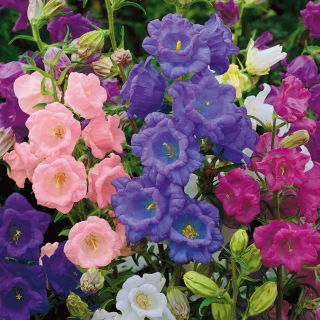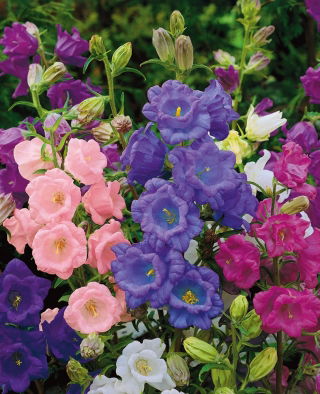The Canterbury Bells, known scientifically as Campanula medium, is an exceptional biennial plant admired for its beauty and versatility in the garden. With its magnificent, bell-shaped flowers that form impressive clusters, it is perfect for flower beds and as a cut flower. This striking plant reaches a height of 80 to 90 cm, making it a standout feature in any garden composition. The Canterbury Bells is a plant with many advantages that gardeners around the world appreciate.
Sowing
The sowing process for Canterbury Bells is crucial for achieving beautiful blooms. Seeds should be evenly spread on the soil surface and lightly pressed in. It is important to maintain regular soil moisture to promote germination and plant growth.
Sowing Depth
Canterbury Bells seeds should be sown at a depth of about 0.3 cm. Such shallow placement in the soil encourages rapid germination and a healthy start. Gently covering the seeds provides optimal conditions for growth.
Direct Sowing Period
When should you sow Canterbury Bells seeds directly into the ground? The optimal time is in May and June. During these months, the weather conditions are conducive to germination and plant growth, allowing for the best cultivation results.
Sowing Period Under Cover
When should you sow Canterbury Bells seeds under cover? May and June are also suitable, allowing for an early start to cultivation and lush blooms in the first season.
Planting Time
The best time to plant Canterbury Bells is from July to August. Transplanting young plants during this period provides them with the right conditions for further growth and development.
Plant Spacing
When planting Canterbury Bells, it is advisable to maintain a spacing of 30x40 cm. This distance between plants ensures they have enough space to grow and prevents competition for nutrients.
Companion Planting
Canterbury Bells pairs beautifully with other ornamental plants like coneflowers and rudbeckias. Together, they create harmonious and aesthetic compositions that draw the eye and add charm to any garden.
Site Conditions
Canterbury Bells prefers sunny or partially shaded locations with well-drained, fertile soil. Regular watering, especially during dry periods, is key to maintaining the plant's healthy appearance. Avoiding overly damp areas can minimise the risk of fungal diseases.
Growing Tips
During the cultivation of Canterbury Bells, regular removal of faded flowers is recommended to extend the flowering period. The plant does not require special care, making it easy to grow and suitable even for novice gardeners.
Plant Height
Canterbury Bells reaches a maximum height of 80 to 90 cm, making it an ideal choice for creating tall garden compositions or as a backdrop for shorter plants.
Flowering Period
The flowering period for Canterbury Bells is from June to September. During this time, the plant impresses with an abundance of flowers, which are a true decoration of any garden.
Usage
Canterbury Bells is perfect for flower beds, where its tall stems and beautiful flowers create a spectacular effect. It also works well as a cut flower, decorating interiors with natural charm.
Resistance to Diseases
Canterbury Bells shows good resistance to most diseases, making it a plant that requires minimal chemical protection. Regularly maintaining healthy soil conditions and avoiding excess moisture further enhances its resistance.
Good to Know
Canterbury Bells is a plant that harmonises beautifully with other species. It attracts bees and butterflies, promoting biodiversity in the garden. It is important to note that it is a biennial plant, forming a rosette of leaves in the first year and blooming in the second.
Why Buy from Garden Seeds Market
Purchasing Canterbury Bells from Garden Seeds Market guarantees the highest quality seeds that have undergone rigorous laboratory testing. Fast delivery and numerous promotions make shopping in our store enjoyable and advantageous. Positive customer reviews confirm the reliability and safety of our products.
The package contains 0.5 g of seeds. The packaging includes information on cultivation guidelines and sowing expiration dates.






